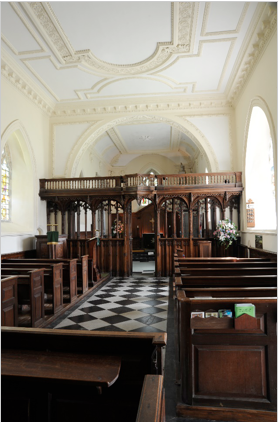About 70 members of The Friends – possibly a record turn-out for one of our visits – toured the churches in the beautiful southern part of the Darenth valley, north of Sevenoaks, on Tuesday 12th September. Fortunately, we had fine weather. We were given an excellent tea at Eynsford church.
We began at St Peter & St Paul, Shoreham, one of the most attractive villages in Kent with its associations with the artist Samuel Palmer. From outside the church looks largely like a late medieval structure, though with a slightly austere flint and red-brick Gothick tower of about 1775. Within, as so often, the story is more complicated. Apart from the tower, the outstanding external feature is the 15th century porch, the most lavish timber porch in the county. Its south portal and adjacent corner-posts are formed of two huge oak timbers and there are pretty, traceried openings in the sides.

The porch at St Peter & St Paul, Shoreham
The interior of the building is a surprise because light and spacious Perpendicular naves are a rarity in Kent. The north wall of the nave must be 14th century, to judge from the window tracery. The rest of the church is of the late 15th or early 16th century, with an arcade of high and slim Perpendicular piers separating nave and south aisle.
The most striking fitting is the rood screen which stretches across both nave and aisle, with a contemporary parclose between chancel and south chapel. The vaulted coving is a 19th century restoration. Other fittings of note are the pulpit of 1832 by Edward Blore, made for the choir at Westminster Abbey and the organ, with an 18th century case, also from the Abbey. There is a late stained glass window by Morris & Co to a design by Burne-Jones and a splendid painting of 1875 depicting the triumphant return to Shoreham of Verney Lovett Cameron after his travels in darkest central Africa.

The interior of Shoreham church, looking east
The church contains no less than four monuments, all with portrait busts, by sculptor Sir Henry Cheere, to members of the Borrett family. That to John Borrett, who died in 1739, is especially fine: happily, the bust of his wife, stolen some years ago, has been recovered but, unhappily, the north chapel which contains the monument has been turned into a partitioned meeting room and is no longer accessible to visitors.

Borrett bust at Shoreham church
We next visited St Botolph, Lullingstone, one of the most enjoyable churches in Kent. It sits like a jewel casket on the lawn in front of Lullingstone Castle and is approached through the castle’s great gatehouse. The building is a late Decorated two-cell church of the middle of the 14th century, with a wooden bellcote on the nave west gable. There is a 16th century north chapel of brick and an 18th century south porch, which looks rather grand and urbane for this humble exterior.

St Botolph, Lullingstone seen from the west

St Botolph: interior looking east

St Botolph: monument to Percyvall Hart
The interior is a delight. It was refitted by Percyvall Hart in the early 18th century. The chancel arch, window surrounds and ceilings are of rich plasterwork and the floor is of back-and-white marble. The reredos, pulpit, pews and font are part of the same refurbishment. The font, easily missed, is no more than a marble bowl in a cupboard just inside the nave door. The most notable fitting is, however, the magnificent rood screen, the best late medieval screen in any Kent parish church, the loft embellished with an 18th century balustrade. There is good medieval glass and two crude, but interesting windows of 1754 by William Peckitt, glass-painter of York.
There is a fine and varied collection of monuments, of which that with recumbent effigy to Sir John Peche, who died in 1522, is the grandest. It stands between chancel and north chapel with an arched canopy rising to the roof. The most surprising piece is, however the monument to Percyvall Hart, date of death 1738, which covers the entire west wall of the north chapel with Rococo-Gothick decoration.
Our tour ended at St Martin, Eynsford, on rather a busy road in the middle of the village but delightful when seen from the far side of the bridge over the river Darenth to the west. St Martin’s is large church for its early date, for it seems to have been built, like the nearby castle, by William of Eynsford in about 1100. There is a wide nave and chancel of this date, the latter with a large apse, a great rarity in these parts. In the 13th century a west tower was built within the western bay of the nave and a large south transept was added, as was the west porch, another unusual feature. The tower has a shingled wooden spire. Inside the porch the fine, original west doorway of the church of 1100 survives. The exterior of the building is of flint and rather over-restored in the 19th century.

St Martin, Eynsford seen from the east

St Martin, Eynsford: west doorway
Within, the church is spacious. The south transept, with its array of lancets, is a noble space. However, the re-ordering of recent years, in which almost all the furnishings were removed, has sacrificed most of the interest and visual appeal, leaving rather a bald interior. The only exceptions are the Perpendicular font and splendid painted arms of George III.

